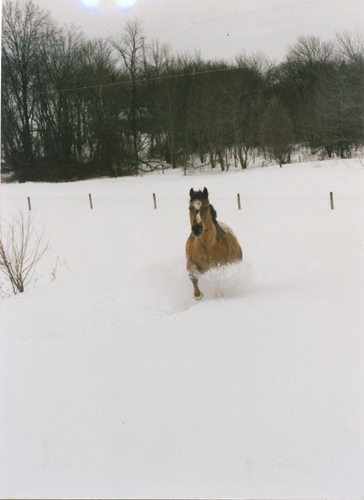As the seasons begin to change, winter will soon affect the coat, health and condition of horses. In some parts of the U.S., that means sub-freezing temperatures, snow and ice, and sloppy terrain. Horse trainers should be sure to take the proper steps to ensure their horses make a smooth transition into winter. Planning ahead for cool weather can prevent costly mistakes, so check the following on your to-do list:Protect medications
Many medications cannot withstand cold temperatures and might physically change, become useless or even harmful if they freeze. Check the labels of all topical, injectable and oral medications for information about proper storage. Most will recommend storing cold-sensitive products in a climate-controlled tack room or home. It is typically advised to keep these medications at a room temperature of 68 to 77 degrees Fahrenheit. If you are uncertain whether a drug is still safe, ask your veterinarian.
Prepare your horse’s feet
If horse owners are planning to pull their horse’s shoes for the winter, it’s best to do so when the weather is still warmer, so it can acclimate before the ground freezes. Consult with a farrier about shoeing choices if necessary. Some horses do better with traction devices, such as borium or studs, and snowball pads may be helpful to prevent wet snow from accumulating under his feet.
Monitor weight
A horse should not lose a significant amount of weight in the winter. Sometimes thick, wooly hair coats can make a horse appear bigger than it is, but don’t be deceived. To ensure equine health, an accurate assessment of the body condition can be done through feeling the horse’s ribs as well as visual inspection. The animal should be at such a weight that you cannot see the ribs but can feel them if you run your fingers over the rib cage applying slight pressure.
Every month during winter, give the horse a body condition score. By the time the horse gets thinner, it may be more difficult for the animal to increase mass during extremely cold weather. It’s worth pointing out that most horses will experience some loss of weight during the winter months regardless of how well fed they are.
Fight off frostbite
Depending on how severe the weather is, horses may be prone to frostbite. If they are living outside or spending a lot of time outside during cold weather, body parts including their ears may be susceptible to chilly elements. Wet, windy and very cold conditions increase frostbite risk. Every stable should be equipped with horse turnout blankets and waterproof horse blankets to help protect horses from the snow, rain and low temperatures. While well-defined manes and thick winter coats provide a first line of protection, it’s always a good idea to keep your horses warm with a winter horse blanket and ear covers.
Inspect blankets
If horse owners are planning on using blankets from last season, they should take them out and examine them before they need them. Mold, insects or rodents may have reached the blankets while they were in storage. Check for frayed fabric, holes, foul smells and loose straps. Replace any blankets that require attention. Also, be sure each garment still fits the horse properly.
Provide electrolytes
It’s true that a horse will generally lose the most electrolytes in the summer and spring, since these (X) ions are lost from the system in sweat. But a horse that remains hard at work throughout the winter season and continues to sweat may need an electrolyte supplement. Provide an adequate amount to ensure a healthy recovery.
Apple-A-Day™ and Orange-A-Day™ are cost effective daily feed supplements formulated to replace lost electrolytes and promote healthy hydration in your horse. No sugars, fillers or artificial colors.








